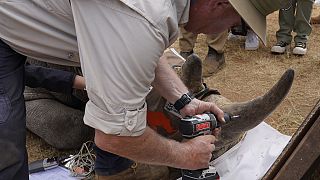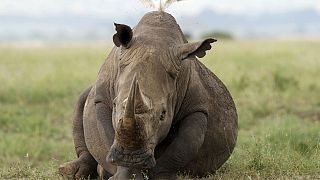Kenya
Black rhinos out for a stroll.
At Ol Pejeta Conservancy in Kenya, 169 black rhinoceros are looked after.
The species is "critically endangered" on IUCN's Red List, and is considered to be on the brink of extinction.
According to IUCN's last assessment in 2020, there were just over 3,100 black rhinos in the world.
In this 90,000-acre (36,000-hectare) conservancy, the animals are protected from their biggest threat: poaching.
"The black rhino, in this country, continues to face serious challenges, (the) majority being threat from rhino poaching, lack of secure habitats that are necessary to reintroduce rhino populations that are growing within the areas that (where) we currently have sanctuaries," says Samuel Mutisya, head of research and species conservation at Ol Pejeta Conservancy, which claims to be the largest black rhino sanctuary in East and Central Africa.
Historically, early settlers in eastern and southern Africa hunted rhinos for sport and sustenance.
Nowadays, the demand for rhino horn predominantly emanates from Asia and the Middle East, where it's falsely believed to possess medicinal properties, or is used for ornamental dagger handles.
On the black market, a rhino horn can fetch up to $60,000 per kilogram.
"In Africa, back in the 1970s, we had 65,000 rhinos roaming freely. Equally, in Kenya, for the same period, we had 20,000. In about 30 years, we crashed to less than 400 in Kenya and less than 4,000 in Africa. Human beings are to blame for this kind of collapse. However, conservation efforts have, over time, borne some fruit. In Kenya, for example, we have a population of about 1,000, and in Africa, it is estimated about 6,500. This is a tremendous result when people pull together for a purpose," says Mutisya.
These sanctuaries require stringent security measures to combat the persistent threat of poaching.
Additionally, they must allow rhinos to exhibit their natural behaviours, including territorial migration and genetically diverse breeding.
But sanctuaries often face another issue: overpopulation.
Rising populations of black rhinos means more territorial disputes, sometimes ending in fatal confrontations.
For instance, Ol Pejeta Conservancy houses 169 black rhinos, but its 'carrying capacity' is 90.
This number refers to the maximum number of rhinos that can be supported by available food and habitat in the sanctuary.
According to Mutisya, more than half of Kenya's rhino sanctuaries have reached their carrying capacity.
"Ol Pejeta is one of such spaces where we are seeing social stress within the population because of having attained carrying capacity. Normally, what you would witness is rhinos fighting each other and a lot of costs going into treatment and veterinary interventions, and that is not something that is sustainable. We are all up for securing any space that we can get to ensure that we address some of these carrying capacity issues that we now see emerging in the population," says Mutisya.
The conservancy has teams of rangers patrolling the grounds.
"Our role here is to monitor rhinos. Each and every day is a rhino day for us," says Stephen Elimlim, head of rhino monitoring at Ol Pejeta Conservancy.
Ol Pejeta Conservancy says they've had no poaching incident in the last six years.
Kenya has made significant strides in reducing rhino poaching, with less than 1% of rhino poaching incidents reported during the implementation of the 6th edition of the Black Rhino Action Plan (2017-2021), and zero poaching cases in 2020.
According to Mutisya, the lack of sufficient funding for essential interventions, such as ranger training and security equipment for rhino protection and law enforcement, remains a persistent challenge.
Black rhinos have a V-shaped hooked lip, allowing them to browse on shrubs, and they prefer thick bush habitats, in contrast to the square-jawed, grazing nature of their white rhino counterparts.
Black rhinos also tend to be more solitary and reticent.
A Wildlife Research and Training Institute (WRTI) and Kenya Wildlife Service report from December 2022 found that Kenya had a combined rhino population of 1,890, made up of 966 black rhinos, 922 southern white rhinos, and two northern white rhinos.












Go to video
First Malaria treatment for babies approved
Go to video
AI videos falsely show Kenyan President resigning following deadly protests
02:16
Kenya's William Ruto faces growing discontent over economy and police brutality
00:28
Nairobi hawker shot at close range by police declared brain dead
01:50
Faith Kipyegon falls short of historic sub-four minute mile but vows to keep pushing
Go to video
Kenya's Interior minister accuses protesters of coup attempt after deadly demos